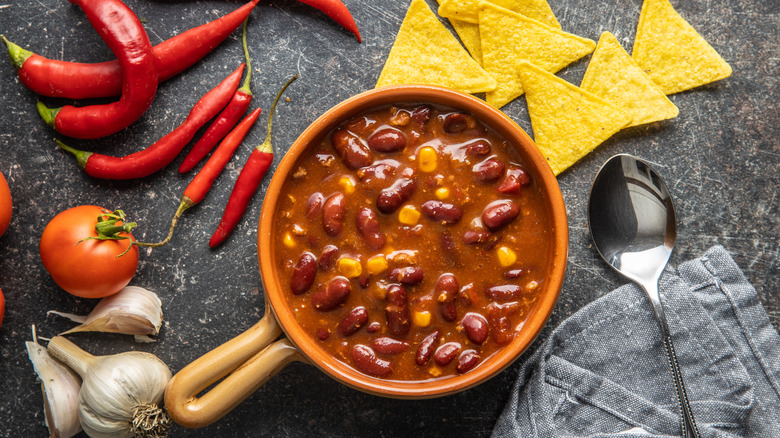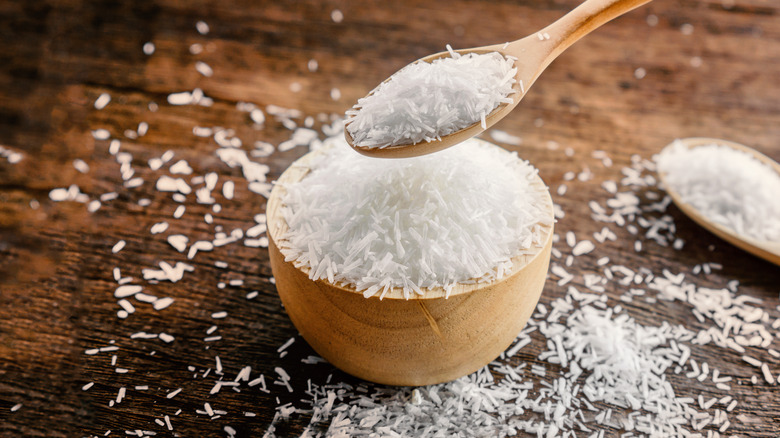The One-Ingredient Trick To Instantly Rescue A Bland Pot Of Chili
We all know the feeling. After considerable time and creative energy poured into a pot of stovetop deliciousness, you taste that first sample spoonful – only to find it's blasé at best. The momentary panic is amplified when that bubbling brew happens to be a pot of supposedly flavorful, savory, spice-loving homemade chili. Fortunately, there's a simple rescue strategy, and it doesn't involve a mad dash to the supermarket.
You only need to have a shaker of monosodium glutamate (MSG) waiting in your pantry. The once-questioned flavor enhancer popular in Asian cooking has shed its cloak of mystery, now occupying an increasingly common spot in everyday kitchens. The FDA has given MSG its standard "generally recognized as safe" (GRAS) designation, explaining that it's a glutamic acid naturally occurring in the human body and in common foods such as tomatoes and cheeses.
A version of the natural substance now exists in the commercially available MSG, coming to the aid of chili chefs everywhere. The rescue operation involves a sprinkle of the white crystalline powder, which injects an earthy umami taste into any dish, including your accidentally bland pot of chili.
How MSG flavors chili
MSG imparts flavor through its glutamate, which activates human taste receptors, specifically the savory, full-bodied umami taste perception. Tasteless on its own, the MSG powder instead pulls out the savory characteristics of whatever food it enters. Healthline explains that it does this in part by stimulating salivary secretion, making your mouth water, and improving the taste of the food.
So, when your batch of bubbling chili lacks that rich depth and flavor kick, just reach for your jar of MSG. It only takes a small amount to jumpstart a batch of chili. Use your own taste buds as a guide, but generally, about one-eighth teaspoon per cup of chili will do the trick.
If your chili recipe includes salt, it's possible to reduce that salt intake by at least partially replacing it with MSG. You get the extra flavor complexity, while potentially alleviating cravings for excess sodium.
The connection between MSG and umami
To some chefs, MSG correlates to the term "aji-no-moto," the longstanding name of a company formed in the early 1900s to market and sell MSG as a flavor enhancer. One of Ajinomoto Group's founding fathers, biochemist Dr. Kikunae Ikeda, pinpointed the "meaty" flavor inherent in his wife's traditional Japanese dashi broth, which came from dried kombu seaweed. That discovery led to the "fifth sense" we now celebrate as umami, named after the Japanese word "umai," meaning delicious.
After Ikeda perfected his method of glutamate extraction from seaweed, it gradually evolved into today's MSG fermentation process employing starches and ingredients such as sugar cane, sugar beets, molasses, cassava, or corn. Almost indistinguishable from the glutamate occurring naturally in everyday foods, the powder form of MSG crystals, often referred to as umami seasoning, now impacts food flavors across the world.
As with the FDA, most health and nutrition experts generally agree that MSG is safe for the majority of people, especially when consumed in moderation. The debunked moniker of "Chinese Restaurant Syndrome" potentially came from MSG misinformation and racist cultural bias.


